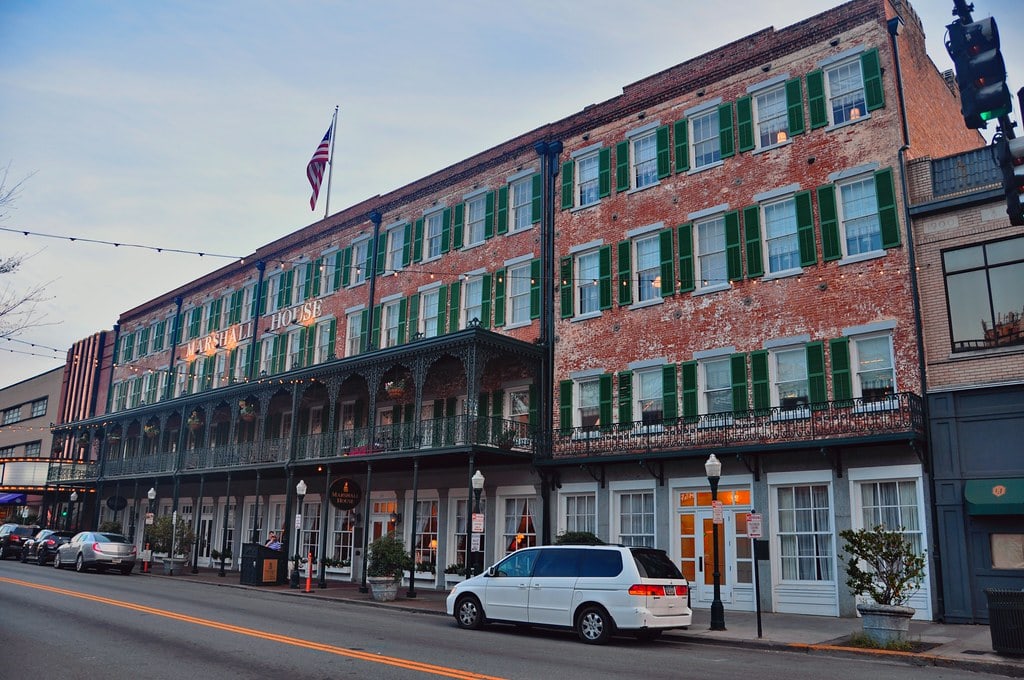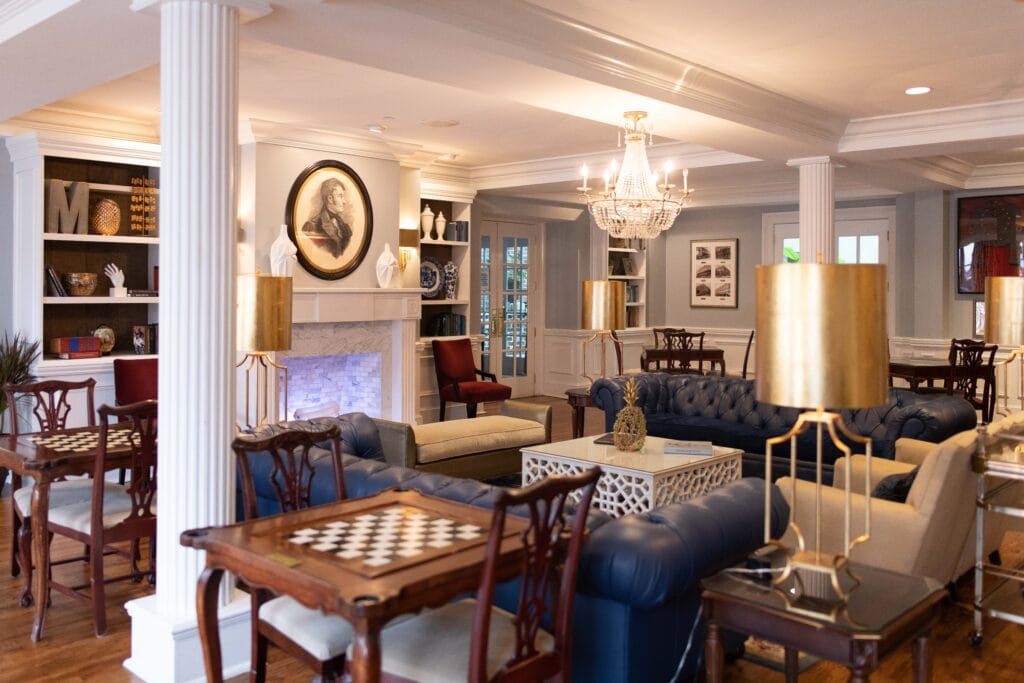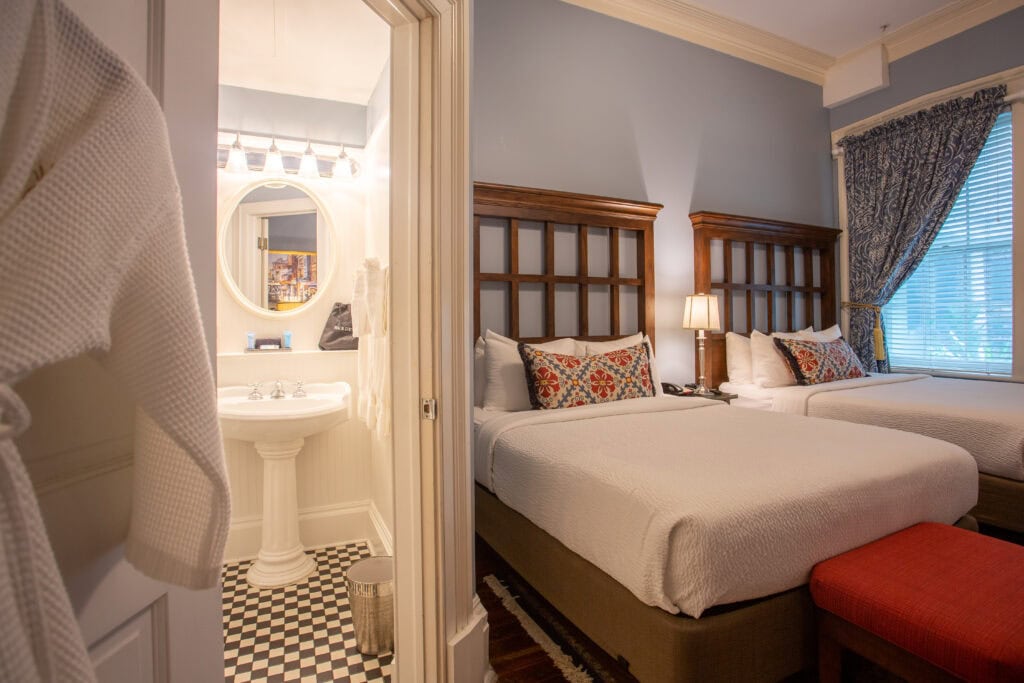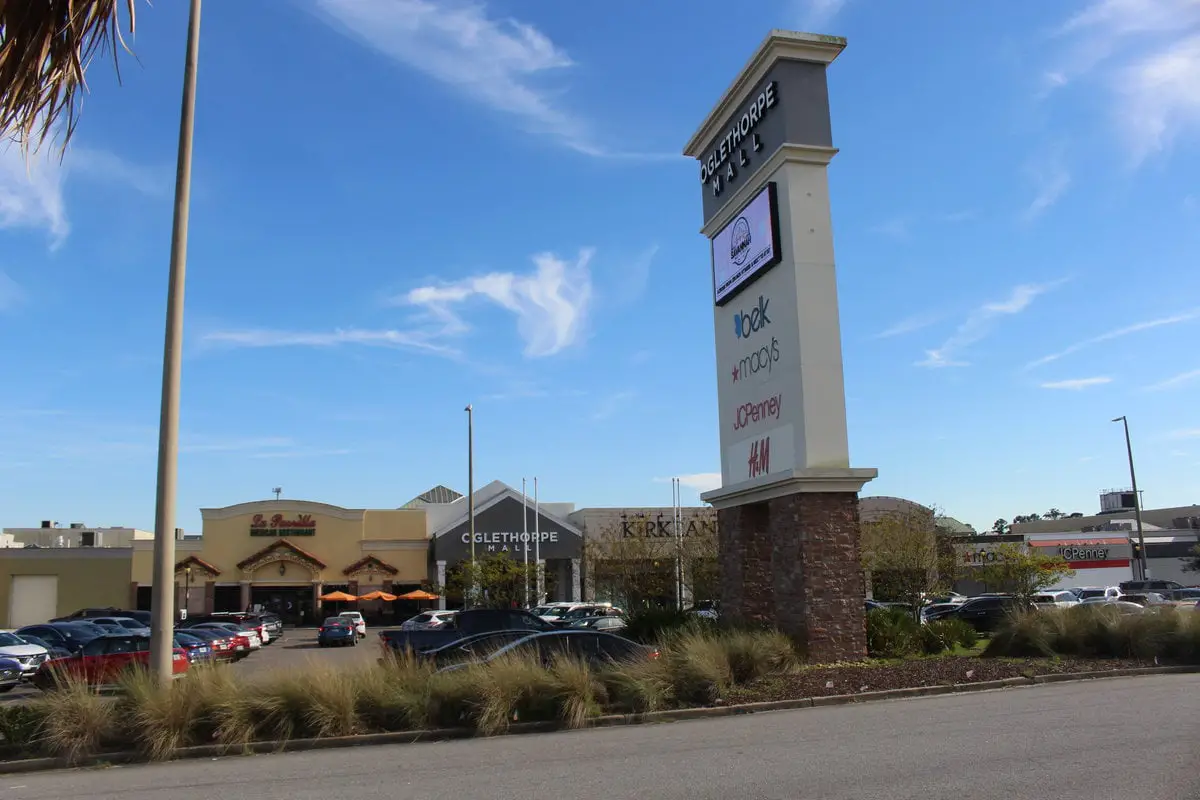Marshall House Origins
The Marshall House was constructed in 1851 by Mary Magdalene Marshall, a Savannah property owner and developer. The four-story hotel was built on Broughton Street, Savannah's main commercial corridor.
Marshall, born in 1783 to cabinetmaker Gabriel Leaver, inherited property after her father died in 1795. She expanded those holdings throughout the early 1800s and became a leading local investor.
She married James Marshall in 1800 and continued managing real estate after he died in 1845.
The building was planned and executed as a hotel, not a conversion.
Its construction coincided with Savannah's rapid population growth and the expansion of rail commerce.
The design followed the Greek Revival style, featuring granite Doric pilasters on the ground floor and Philadelphia pressed brick on the upper façade.
Interior finishes included wide heart-pine floors, high ceilings, and multiple fireplaces.
The roof contained an observation deck overlooking downtown and the port area.
Expansion and Early Success
In 1857, proprietor Ralph Meldrim added a 120-foot cast-iron veranda to the Marshall House.
The structure spanned the entire second floor and became a permanent part of the building's exterior design.
Renovations in 1859 included repainting, new furnishings, and mechanical updates.
The hotel reopened to the public after the work was completed.
In 1867, a volunteer fire department called the Marshall Hose Company was organized to protect the property and nearby structures.
The company was among the first in Savannah to provide dedicated fire coverage for commercial buildings.
In 1880, the adjacent Florida House was incorporated into the Marshall House.
The merger increased total capacity by roughly one-third.
The addition reflected increased traffic and business activity along Broughton Street, which had become Savannah's main commercial corridor by the late 19th century.
War and Hospital Years
The Civil War reached Savannah in late 1864.
Union troops under General William Tecumseh Sherman occupied the city, and the Marshall House was converted into a hospital for wounded soldiers.
It remained a medical site through 1865.
The building's floors, windows, and hallways were heavily altered to handle medical work.
During a restoration project in the 1990s, construction crews uncovered bones beneath the floorboards.
The discovery confirmed decades of local accounts about the building's wartime role.
Today, a display of letters, newspapers, and other artifacts from that period remains on the hotel's third floor, documenting its service during that time.

Epidemics and Hardship
The Marshall House was pressed into service again during the yellow fever epidemics that hit Savannah in the late 1800s.
Twice, it was converted into a hospital during outbreaks that killed thousands across the Gulf Coast.
In 1876, author Joel Chandler Harris fled Savannah during one of those epidemics while working for the Savannah Morning News.
At the time, he lived in the Florida House, which later became part of the Marshall House.
Harris later drew on his Georgia experiences to write the Uncle Remus stories.
Despite recurring public health crises, the hotel continued to operate and adapt.
It closed temporarily in the 1890s but reopened in 1899 with major upgrades.
Electric lighting and plumbing were added to every floor, features that made it one of Savannah's most modern accommodations at the time.
Name Changes and 20th-Century Operation
In 1933, Jacksonville developer Herbert W. Gilbert leased the building and renamed it the Gilbert Hotel.
He renovated the structure and added steam heating, turning it into a full-service operation with 66 rooms, a suite, and several public areas, including a dining room, reading room, and parlor.
Gilbert later sold the property in 1941, but the hotel remained active under new ownership.
For a period, it was known as the Geiger Hotel before the original name returned.
In 1946, the Marshall House reopened after another renovation.
The postwar era brought optimism but also stricter fire and safety standards.
By 1957, the cost of compliance was too high, and the upper floors were closed.
For decades afterward, only the ground level remained in use, occupied by storefronts and small shops.
The upper three stories sat vacant for over forty years, their windows boarded and interiors decaying.

Abandonment and Rediscovery
By the late 20th century, the Marshall House had become a symbol of downtown decline.
Broughton Street's retail core had shifted, and the old hotel stood largely forgotten.
That changed in 1998, when the John Hardy Group of Atlanta acquired the property.
The firm partnered with Paine Webber and Coastal Hotel Group to redevelop it.
Hansen Architects led the design, with Newmark Diercks Design managing interiors.
Historian Kathy Ledvina oversaw archival research to ensure the restoration was historically accurate.
Workers removed layers of stucco that had covered the façade, revealing original Savannah Grey Brick underneath.
The veranda, which had been missing for decades, was reconstructed using 19th-century photographs.
Original woodwork, staircases, and fireplaces were restored, and where pieces were beyond repair, artisans created exact replicas.
Even the gaslight fixtures and room doors were reproduced to match the originals.
The project also enclosed the courtyard with a glass ceiling, turning the once-open space into a bright atrium.
Reopening and Modern Operation
The restored Marshall House reopened in 1999 as a 68-room boutique hotel.
Each guest room preserved its 19th-century character while incorporating modern amenities.
Many rooms feature four-poster beds, original pine floors, and decorative fireplaces.
Balcony rooms overlook Broughton Street from the re-created veranda.
The first floor was reimagined as a restaurant and event space.
45 Bistro, located inside the hotel, quickly became one of downtown Savannah's key dining venues.
Artifacts uncovered during construction, Civil War items, coins, and household fragments are displayed in glass cases on the upper floors.
Together, the hotel's design and exhibits function as both lodging and a living museum.

Reported Haunted Activity
After the Marshall House reopened in 1999, guests began reporting unexplained activity.
Accounts included lights flickering, faucets turning on, and sounds of footsteps in empty hallways.
Room 414 on the fourth floor is most frequently mentioned in reports of doors locking or objects moving without cause.
Contractors working during the 1990s restoration discovered human bones beneath the first-floor boards.
The remains were identified as amputated limbs from the building's Civil War hospital period. Their discovery reinforced the hotel's reputation for hauntings.
Visitors and staff have described occasional odors resembling decay and the sound of children playing in vacant corridors. No mechanical or structural causes were identified for these incidents.
Local tour operators list the Marshall House among Savannah's most visited haunted sites.
The hotel acknowledges the reputation but continues to operate as a standard commercial lodging facility.
Recognition and Ownership
The restoration received two major preservation honors: the Historic Savannah Foundation's Quality Commercial Renovation Award and the Georgia Trust's Preservation Award for Rehabilitation in 2000.
In 2001, HLC Hotels, a Savannah-based company, purchased the property.
The group also owns other restored hotels in the city, including the Gastonian, the Kehoe House, and the Eliza Thompson House.
The Marshall House has remained in continuous operation since.
It appeared on The Travel Channel's Great Hotels in 2003 and was named one of Coastal Living's Top 20 Places to Stay in 2006.
Further renovations in 2008 and 2014 updated the guest rooms, lobby, and library without altering the building's historical framework.
The hotel continues to win "Best of Savannah" honors from local publications.

Legacy
A portrait of Mary Marshall, painted in 1830 by artist Peter Laurens, is displayed behind the hotel's reception desk.
The painting was acquired from the estate of Jim Williams, the Savannah collector known for Midnight in the Garden of Good and Evil.
The artwork recognizes the property's founder and connects the building to later periods of Savannah's cultural history.
The Marshall House is currently recognized as the city's oldest operating hotel.
The hotel continues to operate as both a commercial lodging facility and a designated historic site.
Its ongoing use demonstrates the long-term viability of adaptive reuse for historic properties in Savannah's central business district.




